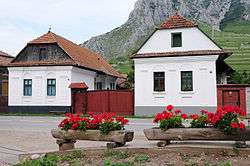Rimetea
| Rimetea Torockó | |
|---|---|
|
Houses in the village center | |
 Rimetea location of the village | |
| Coordinates: 46°27′N 23°34′E / 46.450°N 23.567°E | |
| Country |
|
| County | Alba |
| Government | |
| • Mayor | Francisc Szőcs (UDMR) |
| Population (2011)[1] | |
| • Total | 1,089 |
Rimetea (formerly Trascău; Hungarian: Torockó; German: Eisenmarkt, Eisenburg) is a commune located in Alba County, Romania. It is composed of two villages, Colțești (formerly Sângeorzul Trascăului; Torockószentgyörgy; Sankt Georgen) and Rimetea. A former mining town, today it is known as the location of the Piatra Secuiului (Hungarian: Székelykő, lit. "Rock of the Szeklers") mountain and as a Székely cultural center. In 1999 the village was awarded the Europa Nostra award.
History
.jpg)
The first time it was mentioned was in 1257 under the name Toroczko. As part of the Kingdom of Hungary it belonged to Torda-Aranyos County; after the Treaty of Trianon in 1920 it became part of Alba County in Romania.
At the 2011 census, 91.4% of inhabitants were Hungarians and 8.3% Romanians. At the 2002 census, 76.2% were Unitarian, 12.6% Romanian Orthodox, 5% Reformed, 2.6% Roman Catholic and 2.8% stated they belonged to another religion.
| Wikimedia Commons has media related to Rimetea, Alba. |
References
- ↑ (Romanian) 2011 census data; retrieved on June 29, 2012
Coordinates: 46°27′N 23°34′E / 46.450°N 23.567°E


